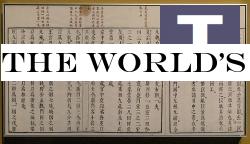INSUBCONTINENT EXCLUSIVE:
This article is part of CGTN's "China in Ink" project, which brings the tremendous world of classic Chinese literature to the fingertips of
global audiences.“The capital city spans a square area, with three gates opening on each of its 2.5-mile-long walls
Three main streets run north-south, and three run east-west
Three paths branch off from each main street.”The excerpt on city-building principles above is taken from the Kao Gong Ji (The Artificer's
Record), the earliest known Chinese text on science and technology
Most of its content was compiled over two thousand years ago during the Warring States Period (475–221 BC), an era marked not only by
unrelenting warfare but also by vibrant advancements in science and technology
It is likely the oldest surviving technological encyclopedia in the world.The surviving text, totaling only around 7,000 characters,
includes manuals on the production of a wide array of handcrafted items from bronze weapons and ornaments to wooden structures and carriages
It also contains the earliest known formulas for mixing copper and tin in specific ratios, adapted to the functional requirements of
different bronze objects, some of which have seen archaeological evidence.Lost for centuries, the text was rediscovered in the Han dynasty
Upon its recovery, court officials chose to append it to the more esteemed Zhou Li (The Rituals of Zhou), a canonical work on ancient
ceremonies and statecraft
In doing so, they also picked the title as we know it today, “Kao Gong,” likely because the office overseeing the manufacture of weapons
was known as “kao gong shi” (考工室).One of the most renowned and earliest surviving editions of the Kao Gong Ji is
found in the Stone Classics of the Kaicheng era
In 837 AD, during the Tang Dynasty (618–907), the Zhou Li, along with eleven other Confucian classics, was engraved onto stone tablets,
with the appended Kao Gong Ji inscribed among them
The oldest printed edition of the manual dates back to the Southern Song Dynasty (1127–1279).Considering the technological level of its
time, the chapter on city planning in the Kao Gong Ji stands as a remarkable achievement
Even more striking is the enduring influence of its principles, which continued to shape urban design for centuries.According to the text,
the royal palace sits at the center of the capital, flanked by the ancestral temple to the left, the Earth God's temple to the right, and
One of the most prominent examples of this enduring legacy is the layout of Beijing
Designed during the Yuan Dynasty (1271–1368), the city was expanded along a central axis running north to south through its historic core,
which is defined by imperial palaces and gardens, sacrificial altars, administrative facilities, ceremonial structures, and major roads that
continue to fascinate people today
The Beijing Central Axis was inscribed on UNESCO's World Heritage List in 2024.

